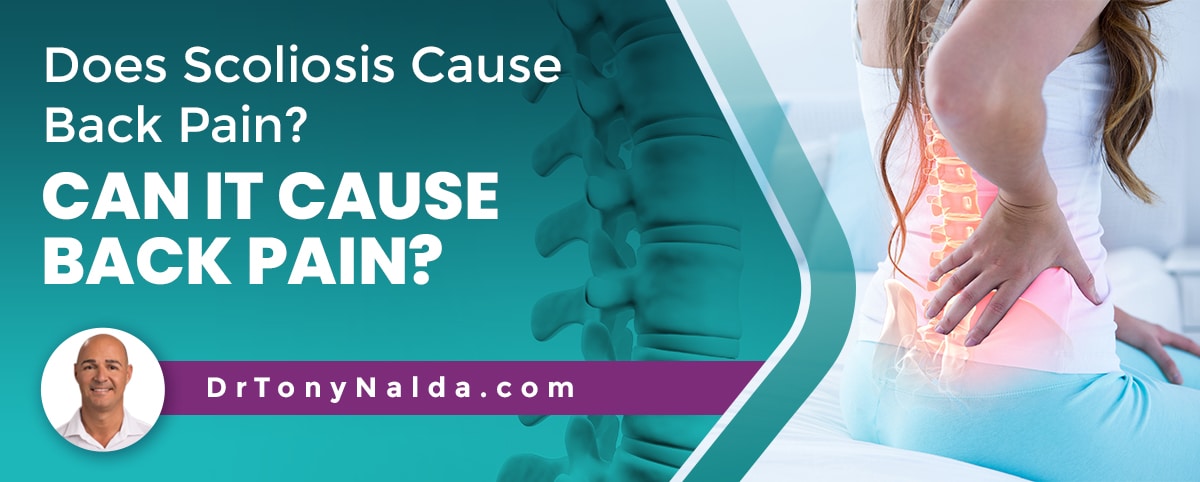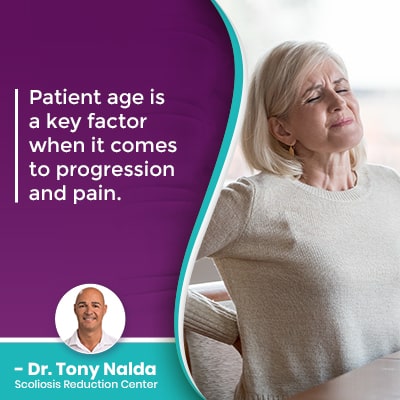Does Scoliosis Cause Back Pain? Can It Cause Back Pain?

Scoliosis can cause a number of symptoms from postural deviation to nerve pain, muscle pain, and back pain; however, as scoliosis doesn't become a compressive condition until adulthood, most children don't experience scoliosis-related pain in the same way. Continue reading to learn the difference, along with how best to remedy scoliosis-related back pain.
Scoliosis can affect the body in a number of ways and involves the development of an unnatural spinal curve that bends to the side and twists, and this can cause carrying levels of back pain; however, pain is more associated with adult onset scoliosis, rather than scoliosis in children.
No two cases of scoliosis will be the same, so let's start with the condition's classification-points, as these help shape a patient's experience of life with scoliosis.
Table of Contents
Classifying Scoliosis
The Scoliosis Research Society puts current estimates at close to seven million people living with scoliosis in the United States alone, and as the most common spinal condition amongst school-aged children, scoliosis awareness is important.
When scoliosis is diagnosed, this means an unnatural lateral (side-to-side) spinal curve, that also rotates (twists), has developed.
Part of the diagnostic process involves further classifying scoliosis based on important patient/condition variables, and these classification-points not only help streamline the treatment process, but also help inform the crafting of effective treatment plans.
As a progressive condition, the nature of scoliosis is to get worse over time, and while there are no treatment guarantees, early detection and intervention does increase the likelihood of treatment success, and the more we know about a condition, the more comprehensive and specific a treatment plan can be.
When it comes to back pain scoliosis, these classification-points can indicate what a patient's likely progressive rate will be, along with whether or not their condition will be painful, and if pain relief will need to be a facet of treatment.
Scoliosis is classified based on patients age, condition type, curvature location, and condition severity.
Patient Age
 Patient age is a key factor when it comes to progression and pain.
Patient age is a key factor when it comes to progression and pain.
Scoliosis can affect all ages from babies to the elderly and every age in between, but it is most commonly diagnosed in adolescents between the ages of 10 and 18 as adolescent idiopathic scoliosis.
Although we don't fully understand what triggers the onset of idiopathic scoliosis, we know that its progression is triggered by growth and development.
So as children grow, I know that monitoring for progression, and working towards holding a curvature reduction throughout growth is going to be the main challenge of treatment; in adults who have reached skeletal maturity, while they still progress, it tends to slow down in adulthood, leaving more time to address their scoliosis.
However, I do know that most adult scoliosis patients are going to need pain management as part of their treatment plans; pain is the main symptom that brings adults in to see me for a diagnosis and treatment.
Back Pain and Scoliosis
As mentioned, scoliosis doesn't become a compressive condition until adulthood, once skeletal maturity has been reached.
 It's compression (uneven pressure) of the spine and its surrounding muscles and nerves that causes the majority of condition-related pain, and this can cause varying levels of back pain.
It's compression (uneven pressure) of the spine and its surrounding muscles and nerves that causes the majority of condition-related pain, and this can cause varying levels of back pain.
In patients who are still growing, their spines are experiencing a constant lengthening motion, and this counteracts the compressive force of the unnatural spinal curve, which is why back pain isn't a common part of the scoliosis-experience for children.
As scoliosis is a structural condition, there is a structural abnormality within the spine itself, and the spine's unnatural spinal curve can cause back pain related to its unnatural position, and as scoliosis progresses, the spinal curve increase in size, becoming more rigid and less flexible.
A stiff spine can cause a lot of back pain and a reduced range of motion.
Nerve-related back pain can also be a symptom of scoliosis as a scoliotic curve can compress the spinal cord within, causing pain that tends to radiate into the extremities.
Back-muscle pain can also be an issue. Scoliosis can cause a muscle imbalance as the unnaturally-curved spine pulls its surrounding muscles in different directions; muscles on one side of the spine can become stretched and loose from overuse, while the muscles on the opposite side can become weak from underuse.
A muscle imbalance can be very painful and cause back pain and muscle spasms.
Condition Type
There are multiple different types of scoliosis, and the most common type of scoliosis to affect both adults and children is idiopathic scoliosis.
In fact, approximately 80 percent of known diagnosed scoliosis cases are classified as idiopathic, and the remaining 20 percent are associated with known causes: neuromuscular scoliosis, degenerative scoliosis, and congenital scoliosis.
Neuromuscular scoliosis can affect children and adults, and is caused by the presence of serious neuromuscular conditions such as cerebral palsy, muscular dystrophy, and spina bifida, to name a few.
Cases of neuromuscular scoliosis are not typical as the underlying neuromuscular condition has to be the focus of treatment, which complicates the process.
Neuromuscular scoliosis involves a disconnect between the brain and the muscles and/or connective tissues that support the spine, and in severe cases, patients can become unable to walk on their own and wheelchair-bound, making the condition especially painful because of its severity.
Degenerative scoliosis affects older adults (50+) as it's caused by natural age-related spinal degeneration.
So with my degenerative scoliosis patients, I know the condition is not only compressive, but also involves spinal degeneration, so is likely to cause varying levels of back pain as the spine deteriorates over time, and relieving pain is a focus of treatment.
With congenital scoliosis affecting approximately 1 in 10,000, it is a rare condition, and as we're talking about babies who are born with the condition, it's not yet compressive, so back pain isn't overly common.
So as you can see, not only does patient age and condition type help focus the course of treatment, it also indicates whether or not a patient's condition is likely to cause back pain.
Curvature Location
There are three main spinal sections, and scoliosis can develop in any, although it's most common in the largest spinal section: the thoracic spine.
The cervical spine refers to the neck; the thoracic spine includes the middle and upper back, and the lumbar spine refers to the lower back.
Scoliosis can also develop in two sections as a combined scoliosis; for example, thoracolumbar scoliosis is common and involves the development of an unnatural curvature of the spine engaging the lower thoracic section and the upper lumbar spine.
While scoliosis can cause effects felt throughout the body, in general, the area of the body located closest to the spinal section affected is going to feel the majority of the condition's direct effects.
So curvature location tells me where to concentrate my treatment efforts, but also indicates the type of symptoms a patient is likely to experience, and the area of the body most likely to be affected.
For example, lumbar scoliosis is associated with sciatic nerve pain as the sciatic nerve starts in the lumbar spine and extends down the back of the lower body, and as a scoliotic curve can compress the sciatic nerve, it can cause pain felt anywhere along the nerve's pathway.
So curvature location can indicate where, if at all, a patient is likely to experience back pain.
The final classification-point is a crucial piece of information that treatment plans are shaped around.
Condition Severity
Condition severity is determined by a measurement known as Cobb angle, and a patient's Cobb angle has become known as the gold standard in the diagnosis and assessment of scoliosis.
Cobb angle is determined via X-ray by drawing lines from the tops and bottoms of the curve's most-tilted vertebrae, and the resulting angle is expressed in degrees.
When the spine's natural curves are in place, its vertebrae are aligned and stacked on top of one another as they should be, but as an unnatural spinal curve develops, some vertebrae become unnaturally tilted, shifting the spine out of alignment.
The higher the Cobb angle, the further out of alignment the spine is, and the more severe the condition:
- Mild scoliosis: Cobb angle measurement of between 10 and 25 degrees
- Moderate scoliosis: Cobb angle measurement of between 25 and 40 degrees
- Severe scoliosis: Cobb angle measurement of 40+ degrees
- Very-severe scoliosis: Cobb angle measurement of 80+ degrees
The more severe a condition, the more likely its continued progression is, the more uneven forces are being introduced to the body, and the more noticeable the condition's effects, like pain, are likely to be.
In addition, the angle of trunk rotation (how much the spine twists from back to front, front to back) is another factor that indicates how painful a condition will be.
The larger the size of the unnatural spinal curve, and the more rotation there is, the more painful a condition is likely to be, particularly in adults for whom the condition is compressive.
Conclusion
So does scoliosis cause back pain: yes, it can, but there are a number of factors that dictate how painful a condition is likely to be, and adults are far more likely to experience compression-related back pain than children.
Back pain can also be caused by unbalanced muscles surrounding the spine that can become sore and stiff, and nerve-related back pain can also be an issue due to nerve compression.
As you can see from the different classification-points, no two cases of scoliosis will be the same, and neither will the ways in which a body responds to the development of scoliosis.
While the main symptoms of scoliosis in children are postural changes such as uneven hips, shoulders, a shoulder blade protruding more on one side than the other, abnormal posture, and the development of a rib cage arch, the main symptom in adults is back pain.
If left untreated to become significantly worse, scoliosis patients are at risk for developing some potentially serious complications such as breathing problems, digestive issues, migraines, leg pain, and permanent leg numbness.
Here at the Scoliosis Reduction Center, when it comes time to treat scoliosis, I customize treatment plans around the aforementioned key patient/condition variables so conditions can be impacted on every level.
When it comes to addressing a spinal imbalance and reducing pain, I do this by addressing its underlying cause: the condition itself.
While some doctors would simply prescribe over the counter painkillers, and prescribe stronger painkillers to help decrease pain in the back caused by scoliosis, this is doing nothing for long-term sustainable pain relief; the best remedy for scoliosis pain is proactive treatment that works towards achieving corrective results so overall quality of life is improved.
I combine condition-specific chiropractic care, physical therapy, and use corrective back braces and rehabilitation to impact scoliosis on every level; this integrative approach can help patients fully recover, and as most cases of scoliosis don't require surgery, this helps them avoid the risks associated with invasive spinal fusion.
Dr. Tony Nalda
DOCTOR OF CHIROPRACTIC
After receiving an undergraduate degree in psychology and his Doctorate of Chiropractic from Life University, Dr. Nalda settled in Celebration, Florida and proceeded to build one of Central Florida’s most successful chiropractic clinics.
His experience with patients suffering from scoliosis, and the confusion and frustration they faced, led him to seek a specialty in scoliosis care. In 2006 he completed his Intensive Care Certification from CLEAR Institute, a leading scoliosis educational and certification center.
About Dr. Tony Nalda
 Ready to explore scoliosis treatment? Contact Us Now
Ready to explore scoliosis treatment? Contact Us Now





